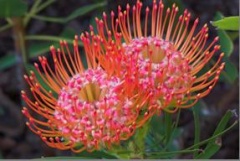Protea, pincushion
| Infobox on Protea, pincushion | |
|---|---|
| Example of Protea, pincushion |  |
| Facts | |
| Origin | - |
| Stowage factor (in m3/t) | - |
| Humidity / moisture | - |
| Ventilation | - |
| Risk factors | See text |
Protea, pincushion
Contents
Description / Shipment / Storage / Risk factors
Scientific Name and Introduction
Proteaceae family. The family Proteaceae includes a diverse range of species of trees and shrubs in the genus Protea from southern Africa and of other genera from Australia whose branches and flowers are used for foliage and as cut flowers. The flowers are normally bird pollinated, and produce copious amounts of nectar, explaining the old Afrikaans name of “sugar bush.” The family name refers to the diversity of forms of the flowers. Additional genera are Banksia, Leucospermum, and Leucodendron.
Quality Characteristics and Criteria
Foliages are cut when mature (no soft tips), and the flowers when at least the outer florets are fully expanded. Banskias may be harvested when at least half of the flowers on the cylindrical spike are open. Make sure leaves are not black.
Grading and Bunching
Quality protea flowers and foliage are free of blemishes, and have reasonably long, straight, stems. Foliage such as ‘Safari Sunset’ leucodendron is bunched in groups. Flowers are handled individually or in bunches of 5 or 10, depending on quality, size, and market demand.
Ethylene Sensitivity
Neither foliage nor flowers of the proteas are affected by exposure to ethylene.
Pretreatments
Species that are susceptible to leaf blackening may be pre-treated by pulsing overnight at 20°C to 25°C with 5% sugar (sucrose or glucose). Higher concentrations may cause leaf blackening.
Storage Conditions
Flowers and foliage from the Proteaceae should be stored at 0°C to 1ºC. Rapid pre-cooling, and maintenance of the proper storage temperature is an important tool in preventing leaf blackening that is a common postharvest problem in proteas. Care must be taken to ensure that there is no condensation or free water on leaves during storage as this greatly increases the incidence of blackening.
Packing
Proteas are normally packed in horizontal fibreboard boxes.
Special Considerations
Leaves turn black due to lack of carbohydrate (food) and warm temperatures. Use preservative solutions and proper low temperature management to prevent leaf blackening. In addition, this disorder can be reduced if the flowers are held under lighted conditions. Leaf blackening is not due to low temperature (chill disorders), nor is it due to poor water relations. Many species and cultivars can be easily dried or preserved by just allowing them to dry under warm, low RH conditions.
Sources used
BMT Consolidated Manual on (Dutch) Flower Bulbs, cut flowers/greens and potted plants.











